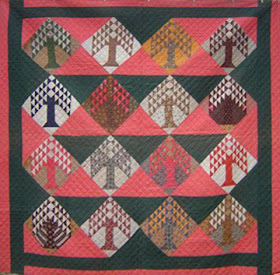Black cotton is one of the best clues for the Quilt Detective---
a reliable clue to a date after 1890.
As I mentioned in a recent post on gray prints, dyers and printers did not have a good black dye for cotton until quite late in the 19th century. In 1893 chemists formulated Vidal Black, a successful cotton dye of a class known as sulfur blacks.
See the post on grays here:
So when you see black cotton in an antique quilt---
think last decade of the 19th century and into the 20th.
We are talking about a true black here, whether solid or print...
With black the background or the figures.
Black was easier to obtain with wools and silks. In the 1880s there was a fad for black silk quilts like crazy quilts. A less expensive option was black wools. So the clue about black after 1890 refers only to cottons.
Both these crazy quilts above are probably from about 1900, the same years when black cottons were so popular.
Like most of the quilts and tops in this post this log cabin variation from an online auction
is probably from 1890 to 1925.
There were earlier ways to get black cottons. When chemists and dyers began experimenting with coal tar or aniline dyes in the 1850s one goal was a direct, color-fast, single-step black for cotton, which natural dyes could not do.
Analine blacks required special washing machinery
as they corroded equipment and fiber.
From William Crookes's 1882 dye manual
Various unsatisfactory formulas for aniline black were developed but they
damaged the roller printing machinery.
In his dye manual Crookes showed an aniline black ground with
figures
of madder red and chrome orange
(the orange seems to have browned.)
Crookes wasn't positive about the new black cotton dye :
“although much praised at first...it finds no favour either with dealers or
consumers.”
Printer Benjamin Hargreaves remembered analine black as better for figures than for backgrounds: "Not a pure black [it] does not look so well in the solid as in the printed specimens." Henry Watts acknowledged the dye's shortcomings. "Analine black is much valued for printing on calico, on account of its brilliancy and permanence. It acquires a greenish hue by long exposure to light and air, but may be brought back to its normal colour by treatment with alkaline solutions."
In other words the black color turned green over time. Another problem was that some processes tendered the cotton so that it disintegrated.
Printer Benjamin Hargreaves remembered analine black as better for figures than for backgrounds: "Not a pure black [it] does not look so well in the solid as in the printed specimens." Henry Watts acknowledged the dye's shortcomings. "Analine black is much valued for printing on calico, on account of its brilliancy and permanence. It acquires a greenish hue by long exposure to light and air, but may be brought back to its normal colour by treatment with alkaline solutions."
In other words the black color turned green over time. Another problem was that some processes tendered the cotton so that it disintegrated.
In addition
to technological problems such as "greening," tendering and machinery
corrosion, trade problems inhibited analine black’s use in the American industry. In the 1890s it was replaced with Vidal and
other sulfur blacks, which maintained their color and were easier for the mills.
Although analine black was available in the 1870s its impracticality meant that it wasn't an option for black cottons for American quilters, one reason that blacks provide such a good clue to about 1890.
The sulfur blacks of the 1890s were not perfect either.
A
1949 dye text noted sulfur black's many advantages, particularly its cost and
its fastness. "Its great disadvantage is instability, with subsequent or simultaneous
oxidation of the sulfur, split off to sulfuric acid, which in turn attacks the
cotton and weakens it considerably or, in extreme cases, reduces it to
powder….dampness and heat hasten the process."
In other words, sulfur black turns into sulfuric acid.
Not every black rotted; quality must have depended on the dyebath. Longevity depended on how the cotton was treated.
Not every black rotted; quality must have depended on the dyebath. Longevity depended on how the cotton was treated.
Dyeing and printing become more sophisticated all the time and the current blacks are far more reliable than those of the past. We don't use sulfur black anymore.
Blacks from my Morris Apprentice collection.
No more tears!





















Interesting! Thanks.
ReplyDeleteI have always loved black in my quilts, love the contrast that it makes. I was looking at, Birds in the Air as a quilt for my bed. I like the simplicity of the design with a touch of appliqué.
ReplyDeleteDebbie
That is very timely information about black in dating quilts - it adds depth to a quilt too. Love that first pictured quilt!
ReplyDeleteI am reproducing a quilt dated 1862 at the moment but it has black stars in it. See the latest post in my blog. Do you think it was miss dated? I'd love your opinion. Thank you.
Hilda
Every Stitch
Me again ... I should have read your words more closely..the quilt I am reproducing was actually made in silk, not cotton. So perhaps 1862 may still be correct??
ReplyDeleteHilda
Hilda---And if it's silk or wool black is no help in dating. I've seen several mid-19th century quilts all of cotton except the black, which is silk. I'll check out your repro.
ReplyDeleteBarbara,
ReplyDeleteIs this why we so much tendering/ popping* in 1840-60 turkey red prints - where the black in the designs looks almost like someone cut it away?
Thank you.
Great post. Thank you. That is information I was able to use today. You rock.
ReplyDeleteThank you for such an informational post. Now I need to go check my old quilts for black fabrics. Do you happen to know the name of that sawtooth star quilt?
ReplyDelete